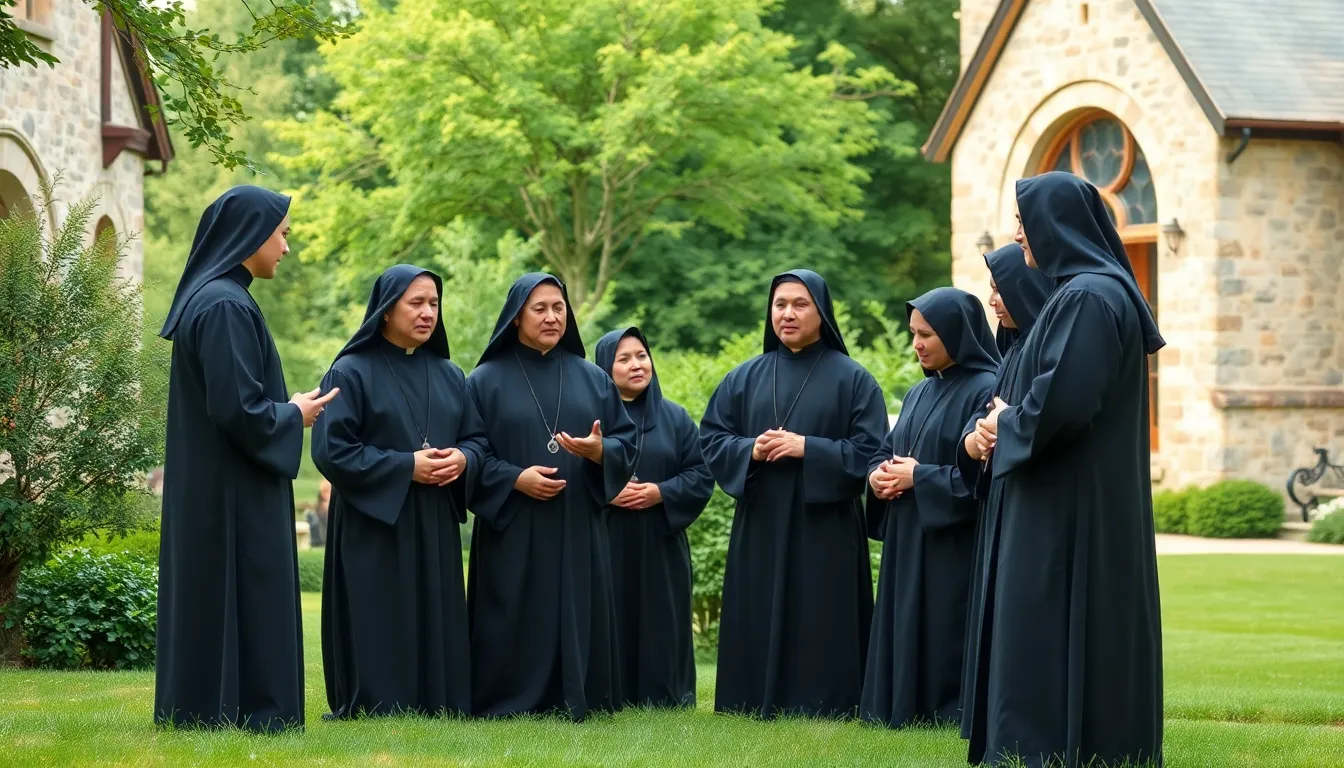Table of Contents
ToggleThe Benedictine habit isn’t just a fashion statement; it’s a symbol of commitment, community, and a dash of medieval flair. Picture this: a monk in a flowing robe, exuding tranquility while managing to look effortlessly stylish. Who wouldn’t want to channel that vibe? This distinctive attire embodies centuries of tradition, reflecting a life dedicated to prayer and work.
But it’s not all about looking good while sweeping the floors of a monastery. The Benedictine habit serves as a reminder of the values of simplicity and humility. In a world obsessed with trends, embracing this timeless garment could just be the antidote to modern chaos. So, whether you’re considering a life of monastic devotion or simply intrigued by the allure of the habit, dive into the fascinating world of Benedictine attire. You might find it’s more than just clothing; it’s a lifestyle choice that brings peace and purpose.
Overview of Benedictine Habit
Benedictine habit serves as a strong expression of monastic life. Monks wear this distinctive garment to symbolize humility and community. The habit includes a tunic, belt, and cape, each part representing fundamental values of the Benedictine order. Simplicity defines not only the appearance of the habit but also the lifestyle that accompanies it.
The colors of the habit often reflect the specific monastery’s tradition. Black commonly symbolizes humility, while brown may indicate a connection to the earth and simplicity. These choices enhance the monastic commitment to live in accordance with the Rule of St. Benedict.
Adopting the Benedictine habit involves embracing a way of life focused on prayer and contemplation. Individuals express their dedication to community through shared garments. Attention to detail in the design of the habit communicates a message of purpose, reinforcing the commitment to spiritual growth.
Wearing the habit fosters a sense of belonging among the monks and the broader community. It represents a collective identity and a shared mission grounded in service, stability, and hospitality. Ultimately, the Benedictine habit acts as an invitation for all to consider deeper values within their own lives. This attire is both practical and meaningful, offering a unique perspective on modern living amidst a chaotic world.
Historical Significance

The Benedictine habit carries rich historical significance, representing a deep-rooted commitment to the monastic way of life. Its components reflect essential values central to the Benedictine tradition.
Origins in Monastic Tradition
The Benedictine habit traces its roots back to the Rule of St. Benedict, established in the 6th century. Monks adopted simple garments to symbolize humility and obedience. Clothing choices conveyed dedication to God and service to others, allowing monks to maintain focus on their spiritual journey. The specific styles evolved to unify the community and set monks apart from laypeople. Monastics wearing the habit embraced a shared identity, reinforcing bonds with one another.
Evolution Over Time
Throughout history, the habit evolved while retaining its core attributes. Initially characterized by basic tunics and cloaks, its design adapted to local customs and climate needs. Each monastery introduced variations in color and fabric, often representing its unique identity. Modern interpretations still honor traditional elements while appealing to contemporary tastes. Some settings now include distinctions for novices and fully professed monks. The enduring nature of the Benedictine habit illustrates its continual relevance in expressing commitment to monastic life.
The Components of Benedictine Habit
The Benedictine habit consists of several key components that reflect the order’s values. Each piece plays a crucial role in expressing the identity and commitment of the monks.
Fabrics and Colors
Fabrics used for the habit, such as wool and cotton, emphasize practicality and durability. Black represents humility, while brown signifies simplicity, forming the foundation of the habit’s color scheme. Various monasteries may choose distinct shades based on local traditions, further reinforcing their unique identities. Adaptations in fabric weight suit different climates, ensuring monks remain comfortable in various environments. The combination of materials and colors serves as a visual representation of spiritual dedication.
Symbolism of Each Element
The tunic, belt, and cape carry significant symbolism in the Benedictine habit. Each garment signifies a commitment to the Rule of St. Benedict and exemplifies humility and obedience. The tunic acts as a reminder of monastic life, with its modest cut reflecting a life devoted to God. The belt symbolizes restraint, while the cape signifies the cloistered life of prayer and community. These elements work together, illustrating shared purpose, service, and stability among monks, fostering a strong sense of belonging within the community.
Daily Life in a Benedictine Habit
Daily routines among monks in a Benedictine habit emphasize a full commitment to spiritual practices and community life.
Spiritual Practice and Identity
Wearing the Benedictine habit shapes a monk’s spiritual identity. Monks engage in prayer and meditation throughout the day. The tunic symbolizes their devotion to God and the Rule of St. Benedict. Consistent adherence to the structure of daily liturgies strengthens their connection to tradition. Participation in communal prayers fosters a shared spiritual journey among monks. Practices such as chanting and scripture reading occur in tandem with the visible commitment of their attire. Devotion radiates through their actions, as clothing reflects both inner spirituality and community values.
Impact on Community Living
Community living thrives within the context of the Benedictine habit. Monks find unity in their shared identity, as the habit encourages collaborative spirit and cooperation. Efforts toward service form the foundation of daily life, reflecting the values of hospitality and stability. Each habit color signifies deeper meanings, reinforcing communal bonds and shared purpose. Fellowship grows through shared activities such as meals and prayer, emphasizing connection among the monks. This visible expression of commitment enhances support networks, enabling each member to contribute meaningfully to the monastic community.
The Benedictine habit transcends mere clothing; it embodies a profound commitment to faith and community. Its simplicity and symbolism serve as a reminder of the values that many seek in today’s fast-paced world. By embracing this timeless garment, individuals can reflect on their own spiritual journeys and the importance of humility and service.
The habit not only connects wearers to a rich monastic tradition but also encourages a lifestyle rooted in peace and purpose. As modern interpretations continue to emerge, the essence of the Benedictine habit remains relevant, inviting everyone to explore the deeper meanings behind their choices and foster a sense of belonging in their own lives.





